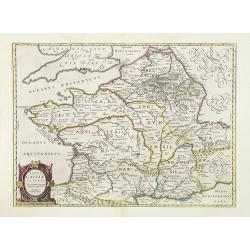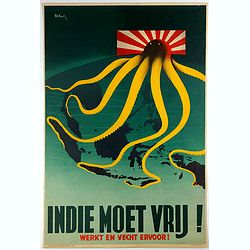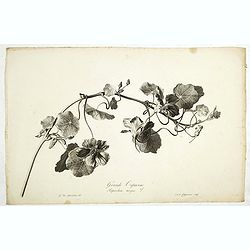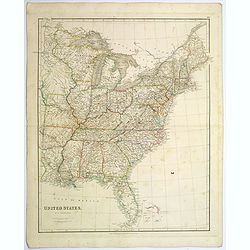Subscribe to be notified if similar examples become available.
[Original Chinese advertising poster for Gande, Price & Co., Ltd. Hong Kong] |
||||||||||||||||||||
|
||||||||||||||||||||
|
|
||||||||||||||||||||
Estimated value: $250 - $250 |
||||||||||||||||||||
Description
A young and pretty Asian woman is sitting on the sofa and giving us a tipsy look. The young woman is being “unladylike” because she is sitting with her legs crossed (improper at that time) and with multiple glasses, on the table, she is not alone.
Advertisement characteristic of 'old Shanghai' in the 1920-1940s, a trend started by American newspaperman Carl Crow who lived in Shanghai between 1911 and 1937, starting the first Western advertising agency in the city and creating much of what is thought of today as the 'sexy China Girl' poster and calendar advertisements.
In today's more liberal China, these are making a comeback and are widely considered minor works of art characteristic of 'Old Shanghai'.
The soft, faded lines, intricate detailing, and the strange proportions of vintage Chinese posters might look strange to contemporary Western designers, especially when the idea of ” good advertisement poster design” as taught in design schools has trended towards the minimalist in the past half a century.
Pre-War Shanghai posters are as distinct a genre as anything that came out of Europe in the years between the 1880’s through the 1930’s. Unconventional and sloppy by Western standards, these unique works of advertising art are nevertheless a cultural treasure, not just for China, but the entire world. Originally intended as ephemeral promotions for the vast array of products that flooded China’s forcibly opened economy, these ads have had a lasting influence in the region that could still be seen in some ways today.
Even while they showcased “the modern woman” in the urban Chinese context, many of these advertisements were already outdated by Western standards by the time they appeared in the 1920’s.
However, they also represented a fusion of Oriental and Occidental styles that was unprecedented. If you look at Chinese art from the late 19th century and Western Art Nouveau and Art Deco from the 1880’s through the 1920’s, it’s clear that these posters were heavily influenced by those styles. Shanghai, already a large international economic center back then in the 1920’s, was ground zero for these varied and often risky advertisements. The most common product advertised by far was cigarettes. Smoking after all, was seen as the mark of the “modern woman” at the time. But while tobacco ads dominated the genre, nearly every consumer product available at the time was marketed with these posters at some point.
Posters made plenty of sense as an advertising medium at the time. Most families in China did not own radios, so radio advertisements were relatively limited in utility. Large billboards were also used, but they were comparatively expensive.
Most of these posters were somewhat sexualized, not unlike many print ads today. The recurring theme of a smiling girl in a tight cheongsam or qipao – which was incidentally also invented in the same era – was thoroughly exhausted for every conceivable product.
After the end of WW2 and the rise of the Communist Party, the aesthetics of these capitalist instruments nonetheless made their way into socialist art, albeit with some influences from the Constructivist styles that were popular with Soviet propagandists.
Advertisements in this style continued to persist at least through the 1960’s even as styles more familiar to us today began to emerge.
We no longer see new poster designs for advertisements in this style even in China these days, but their influences can still be seen now and then, especially in East Asia.
Thanks to a revival in interest, more authentic copies of these posters have been documented, and reproductions are now more popular ever. But even this popularity pales compared to the demand for copies of popular European poster examples from the Art Nouveau and Art Deco era. As time marches on, more original copies are lost to us. One hopes in the near future, vintage and antique posters from early-to-mid 20th century China get the worldwide recognition they deserve.
More about Vintage Shanghai Posters [+}
FAQ - Guarantee - Shipping
Buying in the BuyNow Gallery
This item is available for immediate purchase when a "Add to Cart" or "Inquire Now" button is shown.
Items are sold in the EU margin scheme
Payments are accepted in Euros or US Dollars.
Authenticity Guarantee
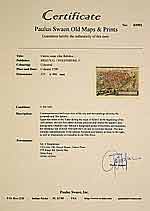 We provide professional descriptions, condition report (based on 45 years experience in the map business)
We provide professional descriptions, condition report (based on 45 years experience in the map business)
Paulus Swaen warrants the authenticity of our items and a certificate of authenticity is provided for each acquired lot.
Condition and Coloring
We indicate the condition of each item and use our unnique HiBCoR grading system in which four key items determine a map's value: Historical Importance, Beauty, Condition/Coloring and Rarity.
Color Key
We offer many maps in their original black and white condition. We do not systematically color-up maps to make them more sellable to the general public or buyer.
Copper engraved or wood block maps are always hand colored. Maps were initially colored for aesthetic reasons and to improve readability. Nowadays, it is becoming a challenge to find maps in their original colors and are therefor more valuable.
We use the following color keys in our catalog:
Original colors; mean that the colors have been applied around the time the map was issued.
Original o/l colors; means the map has only the borders colored at the time of publication.
Colored; If the colors are applied recently or at the end of the 20th century.
Read more about coloring of maps [+]
Shipping fee
A flat shipping fee of $ 30 is added to each shipment by DHL within Europe and North America. This covers : International Priority shipping, Packing and Insurance (up to the invoice amount).
Shipments to Asia are $ 40 and rest of the world $50
We charge only one shipping fee when you have been successful on multiple items or when you want to combine gallery and auction purchases.
Read more about invoicing and shipping
FAQ
Please have a look for more information about buying in the BuyNow gallery
Many answers are likely to find in the general help section.
Virtual Collection
![]()
With Virtual Collection you can collect all your favorite items in one place. It is free, and anyone can create his or her Virtual map collection.
Unless you are logged in, the item is only saved for this session. You have to be registed and logged-in if you want to save this item permanently to your Virtual Collection.
Read More[+]
Register here, it is free and you do not need a credit card.
Add this item to
Virtual Collection
or click the following link to see my Virtual Collection.
| High-Resolution Digital Image Download | |
|
Paulus Swaen maintains an archive of most of our high-resolution rare maps, prints, posters and medieval manuscript scans. We make them freely available for download and study. Read more about free image download |
In accordance with the EU Consumer Rights Directive and habitually reside in the European Union you have the right to cancel the contract for the purchase of a lot, without giving any reason.
The cancellation period will expire 14 calendar days from the day after the date on which you or a third party (other than the carrier and indicated by you) acquires, physical possession of the lot. To exercise the right to cancel you must inform Paulus Swaen Europe bv, which is offering to sell the lot either as an agent for the seller or as the owner of the lot, of your decision to cancel this contract by a clear statement (e.g. a letter sent by post, or e-mail (amsterdam@swaen.com).
To meet the cancellation deadline, it is sufficient for you to send your communication concerning your exercise of the right to cancel before the cancellation period has expired.
![Old map image download for [Original Chinese advertising poster for Gande, Price & Co., Ltd. Hong Kong]](/uploads/cache/45059-500x500.jpg)
